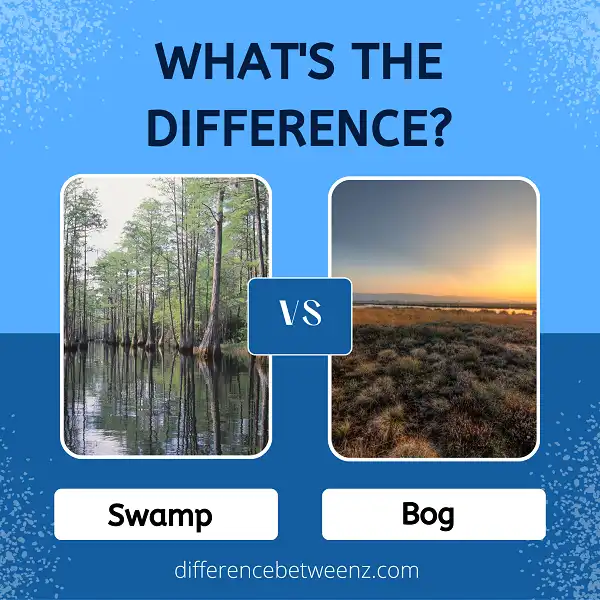What’s the difference between a swamp and a bog? swamps are typically freshwater habitats containing waterlogged soils, while bogs are acidic habitats containing waterlogged peaty soils. Both swamps and bogs can provide important ecological services, such as flood control, carbon storage, and wildlife habitat. Understanding the difference between swamps and bogs is important for conserving these valuable ecosystems.
What is Swamp?
Swamp is a term used to describe a wetland that is forested. Swamps are habitats for many amphibians, reptiles, birds, and mammals.
- Many swamps have crawling or wading animals such as snakes, frogs, and salamanders. Swamp habitats are found on every continent except Antarctica. Swamps are characterized by very slow-moving or stagnant water and by excessively damp soil. The primary factor that distinguishes a swamp from other types of wetlands is tree growth; swamps generally have trees growing in them, whereas other wetlands do not. Other factors include water level and nutrients. Swamps are divided into two main types: temperate and tropical.
- Temperate swamps are found in Europe, North America, and parts of Asia. They are home to hardwood trees such as oak and maple. Cypress trees are also common in temperate swamps. Insects, reptiles, amphibians, fish, and mammals all live in temperate swamps. Tropical swamps are found closer to the Earth’s equator in Africa, South America, and Southeast Asia. Trees that grow in tropical swamps include mangroves, palms, and cypresses. Like temperate swamps, tropical swamps support a diverse array of plant and animal life.
- Swamps play an important role in the global ecosystem by providing habitat for many organisms and serving as a natural filter for pollutants. Swamps also help to regulate local water levels by storing excess water during periods of heavy rainfall and releasing it during droughts. In some areas, swamp ecosystems have been heavily impacted by human activity; however, many Swamp conservation efforts are underway to protect these important ecosystems.
What is Bog?
Bog is a type of wetland that is characterized by its spongy, peat-filled terrain. Bogs form in areas where waterlogged ground prevents the decomposition of plant matter. As a result, layers of dead plants accumulate over time, creating a spongy surface layer known as peat. Bog ecosystems are home to a variety of unique plant and animal life, including carnivorous plants such as pitcher plants and sundews. Bog ecosystems also plays an important role in regulating regional water levels and preventing flooding.
Difference between Swamp and Bogs
Swamp and bog are both wetlands. They are characterized by being wetland areas that are poorly drained and contain water that is stagnant or slow-moving. Both swamp and bog have similar plant life, such as mosses and cypress trees. The main difference between swamp and bog is that swamp has a greater variety of plant and animal life than bog. Swamp also has nutrient-rich soil whereas bog has nutrient-poor soil. Swamp is teeming with life while bog is relatively barren. Swamp is the better choice if you’re looking for more variety in terms of plant and animal life. If you’re looking for a more serene and quiet landscape, bog might be the better choice for you.
Conclusion
A swamp is a wetland that is forested and has more open water than a bog. Swamps are usually found near rivers, in low-lying areas, and in the tropics. Bogs, on the other hand, are wetlands that have more peat mosses than trees. They form when rainwater seeps through the soil and accumulates over time. Bogs are typically found in high-latitude locations or at elevations above 3,000 feet (910 meters). So now you know the difference between swamps and bogs!


